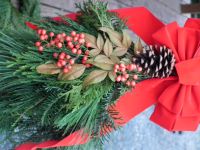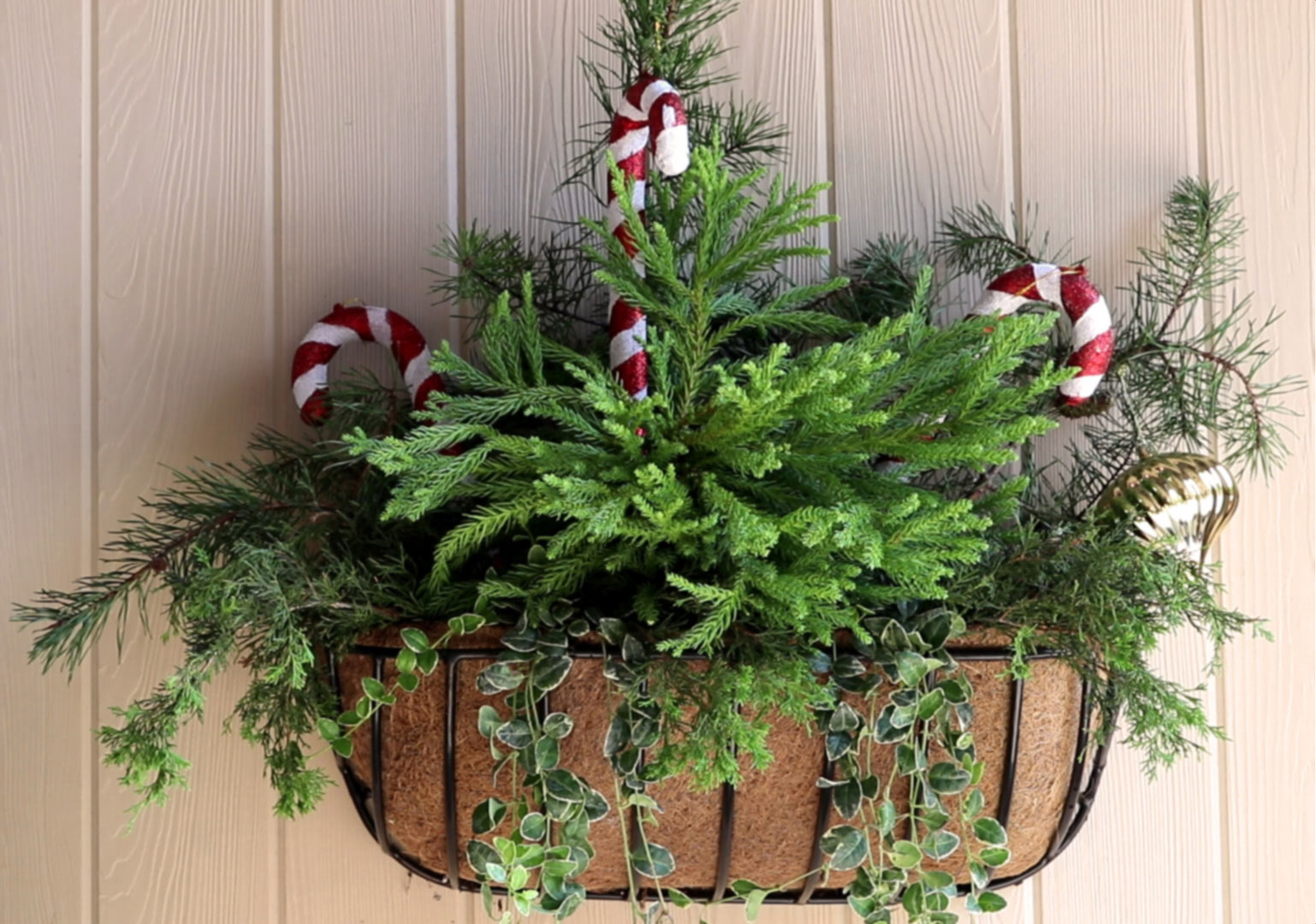Holiday decorations don't have to be expensive, or time-consuming to
create. Chances are you already have the makings of some naturally
beautiful arrangements right outside your door. Conifers such as
Leyland cypress, pine, arborvitae and juniper, and broadleaf evergreen
holly and nandina are common landscaping plants that work quite well.
Accents
of berries, pine cones, grass inflorescences and dried flowers can
easily be found in the late fall and winter landscape as well. All of
these can be used to create a design from scratch, or to elevate plain,
less costly wreaths and roping. We've put together some tips for you on
creating quick decorations with foraged materials.
Tools & materials you'll need:
- Pruners (preferably with 3/4" diameter cutting capacity)
- Containers filled with previously used soil or sand
- Florist wire
- Cut greens, colorful stems, berried stems, pine or spruce cones, faded flower heads
Optional:
- Flower frogs or florist foam
- Anti-desiccant spray (Wilt-Pruf)
- Shatterproof outdoor ornaments
Harvesting:
- Take cuttings from the back or inside of plants where it will not be noticed.
- Make proper cuts as you would for pruning. Be sure you know the correct pruning method for the type of conifer you have--spruces and junipers can be tricky.
- Place cut stems in water if not using immediately
- For longer lasting greens, spray with an anti-desiccant like Wilt-Pruf. Let dry outside before bringing in.
- If buying a cut tree, ask for any branches removed during the fresh cut. If you ask nicely, they may give you additional cut branches as well
- If foraging native plants in wild areas, harvest gently and responsibly--only a few stems from each plant.
- If foraging invasive species in wild areas, be sure to prevent spreading the plant. Place material immediately in bags. For disposal of small amounts of material, DO NOT COMPOST. Place in black plastic bags and allow to sit in the sun for several weeks to be sure plant parts are no longer viable. You can find more information about disposal of invasive species at your state government website, or use these suggestions.
- When foraging in wild areas, please be sure you know what poison ivy/sumac look like in all seasons--the berries can be quite attractive!
With a floral frog, you can easily create arrangements as simple or complex as you desire. Floral frogs consist of a heavyweight base covered with sharp rust-proof pins. The pins will hold your stems as you desire. The frogs can be used alone, or placed in decorative saucers, bowls, baskets, or vases. The advantage to frogs over florist foam is that they are reusable, smaller, and easily stored. They also allow for more resetting of stems as you arrange, unlike the less forgiving nature of florist foam which will degrade the more you puncture it.
Very simple arrangements might consist of just a cluster of berries, a stem or two of greens, and a pine, spruce, or magnolia cone. We recommend nandina berries where available, as they are possibly poisonous to some birds and they may invasively spread by seed, so are better off removed from the environment whenever possible.
For fuller designs, set in the tallest and widest greens as a base, then fill in around with stems of different foliage textures and colors, adding a final accent of bright berries. Placing a small sculpture or treasured ornament nearby can create a pleasing effect. Or choose a frog designed to hold a taper candle in the center for a charming traditional look.
Designs can be worked front to back, as here, or in a full circle, depending on anticipated placement and viewing angle.
The frog can be set in a bowl or saucer, and surrounded with preserved moss if desired. The frog arrangements can also be set into glass vases, then covered with decorative stones, marbles, or colored glass. This works well with fresh flowers and other designs that require water. Greens arrangements without water can be misted heavily, but avoid spraying berries as they may deteriorate.

This is the perfect "cover-up" for your empty containers! As long as the pots are frost proof the arrangements can be left all winter. If you have a ready supply of greens, stems can be refreshed as needed. If you have a container without soil, you can fill it cheaply with sand, but note that it will be much heavier than potting soil, so you may need to place it where desired before filling. Water the sand or soil well, then place the largest stems first, filling in with shorter stems toward the edges. Just like a regular container, you can add "trailing" elements with angled branches placed almost sideways, weeping spruce, and other soft-stemmed branches. Finally, accent with berries, colorful stems, grass inflorescences, dried flower stems, and ribbon if you desire.
Hanging baskets and window boxes, too! Simply cut back the old annuals and place the cut stems directly into the used soil. Keep all containers watered to keep greens fresher. Any evergreen planted in the container can be left in place and incorporated into the design. With hayrack window planters (see photo at top of article) or baskets, greens can even be woven through the bars if you don't wish to leave your liners and soil in place. Fill in with weatherproof ornaments for a bright pop of color. Strings of LED lights can be woven into any of the arrangements for extra night-time grandeur.
One of the prettiest decorations is a small evergreen tree (live or cut) with red berried stems of winterberry, holly, or nandina. Simply wire the berried stems into the tree wherever you choose--the more the merrier!

No need to pay ridiculous amounts for decorative greens items like door swags or door charms. These are ultra simple to make. Just arrange a base layer of evergreen stems into an elongated diamond shape and wrap at the top with florist wire or twine, and leave a loop for hanging. Then layer your accents on top, from longer to shorter and wrap the stem ends again at the top with wire. You can trim off any stems at the top that are too long.
If you choose you can wire on a pine cone--just wrap the wire about 1/3 of the way from the bottom of the cone, push the ends through the greens and pull tightly to twist & secure at the back of the arrangement. Short berry stems can be added in the same way. Wrap a bow around the top to hide the wire--all done!
Buy the simplest, least expensive wreath you can find and add your own decorative accents for a uniquely beautiful display. Usually this will be a balsam fir wreath--if you're hanging on a door, make sure it's a single-faced wreath--you don't need to pay for a double-faced wreath when no one will see the other side.
Often your decorative stems can be simply pushed into place on a ready-made wreath. Just make sure they are facing in the same direction as the existing stems--either clockwise or counter-clockwise. Give them a little tug to be sure they're tight. You can secure with a bit of wire if necessary.
If you're the type that likes a little more bling to ring in the holiday, then avail yourself of the many spray paints and glitters you'll find in your local craft store. When applying to natural elements, go easy with the shiny stuff, though--a little goes a long way. With pine cones and the like, a light spray that hits mostly the tips looks best. White spray paint is nice for snowy effects--again, just a touch. If you don't have red twig dogwood stems you can paint branches that have fallen from trees. Use an inexpensive white or black spray paint to prime these first, as they will absorb paint so much that it takes several coats. To apply glitter, spray a mixture of white glue and 4 to 5 parts water, then sprinkle the glitter on top as you like, adding an extra light spray of glue once almost dry.
Your garden holds many treasures just waiting to be found! Here's a sampling of materials you might try:
Herbs: rosemary, lavender, santolina grey or green, faded flowering stems of basil, dill, or parsley
Conifers: pine, juniper, spruce, cryptomeria (wonderful clusters of cones, also), yew (easy to prune and grows back quickly), Hinoki cypress, arborvitae, Leyland cypress, fir
Broadleaf evergreens: nandina, holly, magnolia, photinia (berries also), privet, euonymous, osmanthus (especially variegated Goshiki), leucothoe, boxwood, distyllium
Cones/seed heads: pine, spruce, cypress, cryptomeria, magnolia, oak (acorns & caps), sweet gum, buttonbush, sycamore, sedum, hydrangea, clematis, sumac, angelica, phlox, echinacea, milkweed, hibiscus
Berries: nandina, winterberry, holly, rose hips, juniper, bittersweet, hedera ivy (forms blue berries when allowed to climb), porcelain vine

